Near
Chittagong you can find several ship breaking yards. They are situated a
few kilometers outside the city. Ships are taken apart here and the
material is reused as far as possible. It is hard work for very small
wages. The labor conditions are appalling,
everything is done by hand. This is probably why the managers of the yards
are not very enthusiastic to let foreigners with big cameras in; they are
afraid you
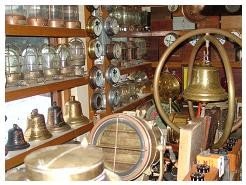 are
a journalist and you might spread the bad news about their inhuman
behavior. The steel
parts from the ships are sold, the inside is used to built small boats,
which you see on the rivers of Bangladesh. Everything
else inside the ship, like furniture, lamps, clocks, taps, toilets and
many other things, are sold in the shops that line the road nearby. The
copper items which look very "shiplike", like oil lamps and
ship clocks, are copied ("Made in Bangladesh") and sold in the shops for a
high price. We managed to find exactly the same items in shops in Dhaka
for a much lower price. Unfortunately, it was raining cats and dogs on the
day we were there, and we only managed to make a few pictures from the
entrance gates, trying to keep ourselves and the camera dry under the
umbrella. are
a journalist and you might spread the bad news about their inhuman
behavior. The steel
parts from the ships are sold, the inside is used to built small boats,
which you see on the rivers of Bangladesh. Everything
else inside the ship, like furniture, lamps, clocks, taps, toilets and
many other things, are sold in the shops that line the road nearby. The
copper items which look very "shiplike", like oil lamps and
ship clocks, are copied ("Made in Bangladesh") and sold in the shops for a
high price. We managed to find exactly the same items in shops in Dhaka
for a much lower price. Unfortunately, it was raining cats and dogs on the
day we were there, and we only managed to make a few pictures from the
entrance gates, trying to keep ourselves and the camera dry under the
umbrella.
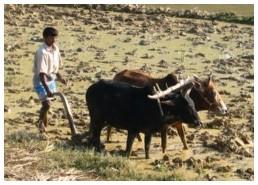 From
Chittagong, we went to
Cox's Bazar to
catch the boat from Teknaf, the very Southern part of mainland bangladesh, to
St
Martin's Island. The
road, with a length of a little over 150 kilometers, goes through
flatlands as well as hills (the last part of the Himalayas) and is
beautiful. Everywhere you see paddies, and farmers with ploughs and oxen.
All the work is done by hand. Most people work
either at sea, or on the land. The farmers hardly use any machines. The
road curves from left to right and runs through a lot of From
Chittagong, we went to
Cox's Bazar to
catch the boat from Teknaf, the very Southern part of mainland bangladesh, to
St
Martin's Island. The
road, with a length of a little over 150 kilometers, goes through
flatlands as well as hills (the last part of the Himalayas) and is
beautiful. Everywhere you see paddies, and farmers with ploughs and oxen.
All the work is done by hand. Most people work
either at sea, or on the land. The farmers hardly use any machines. The
road curves from left to right and runs through a lot of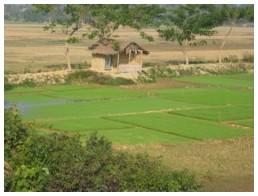 small villages. In the
villages, the roads are very full; full of people on foot, rickshaws,
cars, and all sorts of animals. You will see dogs, goats and cows walking
around. Also there is a lot of trade going on and a lot of people are
trying to sell their goods on the street. Everybody uses the horn to make
their way through the crowd, so the effect is nil; you only come out
deaf. small villages. In the
villages, the roads are very full; full of people on foot, rickshaws,
cars, and all sorts of animals. You will see dogs, goats and cows walking
around. Also there is a lot of trade going on and a lot of people are
trying to sell their goods on the street. Everybody uses the horn to make
their way through the crowd, so the effect is nil; you only come out
deaf.
Even after dark it is still crowded. Luckily after dark the rickshaws here
have little oil lamps under their carriage, so they are at least visible
if you look hard. |
|
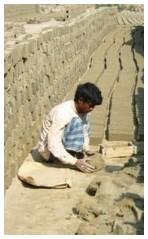 The
road goes along the river Karnaphuli. "Karnaphul" means
"flower adorning from the ear" and hints back to a legend where
a princess dived from a boat into the river since she lost the flower that
her prince lovingly had put behind her ear. Since she was carried away by
the currant, the prince, struck by grieve, jumped after her. None of both
was ever to be seen again. The
road goes along the river Karnaphuli. "Karnaphul" means
"flower adorning from the ear" and hints back to a legend where
a princess dived from a boat into the river since she lost the flower that
her prince lovingly had put behind her ear. Since she was carried away by
the currant, the prince, struck by grieve, jumped after her. None of both
was ever to be seen again.
Left and right from the
road you see many brick bakeries, some with one, others with two pipes,
some of the pipes beautifully decorated. They are mostly very small
factories, where a lot of men are walking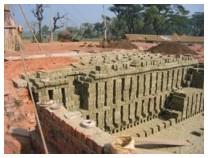 and hanging around but only a few are really working. In the dry season,
they get clay from the
border of the river Karnaphuli.
and hanging around but only a few are really working. In the dry season,
they get clay from the
border of the river Karnaphuli.
The
clay is put in a mal, only one brick at the time, so it takes ages to
produce an impressive quantity. At the bottom of the mal are the initials
of the factory owner. After
the bricks are formed, they are left to dry in the sum for a week or so.
After that, they are put in a very primitive oven, where they will bake
one night. In the same oven sometimes unpopular people have been known to
be baked. The result was not very healthy. After baking, the bricks are
sold and mostly transported to the big city. The prices vary from 3 to 5
Taka a piece, depending on the quality.
|
 are
a journalist and you might spread the bad news about their inhuman
behavior. The steel
parts from the ships are sold, the inside is used to built small boats,
which you see on the rivers of Bangladesh. Everything
else inside the ship, like furniture, lamps, clocks, taps, toilets and
many other things, are sold in the shops that line the road nearby. The
copper items which look very "shiplike", like oil lamps and
ship clocks, are copied ("Made in Bangladesh") and sold in the shops for a
high price. We managed to find exactly the same items in shops in Dhaka
for a much lower price. Unfortunately, it was raining cats and dogs on the
day we were there, and we only managed to make a few pictures from the
entrance gates, trying to keep ourselves and the camera dry under the
umbrella.
are
a journalist and you might spread the bad news about their inhuman
behavior. The steel
parts from the ships are sold, the inside is used to built small boats,
which you see on the rivers of Bangladesh. Everything
else inside the ship, like furniture, lamps, clocks, taps, toilets and
many other things, are sold in the shops that line the road nearby. The
copper items which look very "shiplike", like oil lamps and
ship clocks, are copied ("Made in Bangladesh") and sold in the shops for a
high price. We managed to find exactly the same items in shops in Dhaka
for a much lower price. Unfortunately, it was raining cats and dogs on the
day we were there, and we only managed to make a few pictures from the
entrance gates, trying to keep ourselves and the camera dry under the
umbrella.